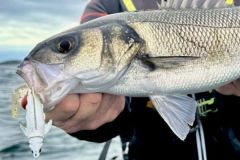Take the season into account
Seasonality is a parameter to be taken into consideration, as it has a direct impact on the activity zones where sea bass are found. Keep in mind that what drives the arrival of these fish is food. As soon as you locate forage fish and shellfish areas, bass will be present. However, depending on the time of year you fish, some spots are more favorable than others.
At the start of the season, sand eels are very common along our coasts. Head for the sandy areas.

When bluefish, such as sardines and sprats, are present, bass are more likely to be found on the rocky plateau. In this case, I mainly use shad lures in line with the size of the prey the bass hunt.
Shallow water zones
These areas are often close to the shore. They are usually home to posted or marauding fish. I usually catch them on the fly or swimming fish to quickly cover a large area.
The water warms up quickly compared to the deeper offshore areas, which can be exposed to currents. This kind of spot is ideal at the start of the season. Food, such as forage fish, crabs and crustaceans, is plentiful. Sea bass, returning from spawning, will find plenty to feed on after this harsh winter period.

Estuaries
These areas are home to a large quantity of food due to the water temperature, which is higher than offshore. Fish are often posted here, and it's rare to find active sea bass. Fishing is possible by boat, although this is a popular area for shore anglers. Here, it's scratch-offs with Texan montages that I like to use to track down sea bass.
The rocky plateaus of the open sea
These are the most commonly fished areas for anyone wishing to catch sea bass. Situated at depths of between 10 and 20 meters, you'll find an alternation of rock and seaweed, with more or less significant drop-offs. These areas are home to both posted and hunting fish.

I target these areas in spring, when the bass are still grouped together. The catches are often similar in size, and you'll have to go off the beaten track to hope for bigger fish. On the other hand, if you find active bass, it's possible to make a series of catches.

High-current areas
These are the spots that attract sea bass, as we like to say among anglers. Here, the current is strong, the water highly oxygenated and the fishing is often technical. The speed of the drift, combined with a very uneven underwater relief, makes fishing these spots quite complicated.

You'll need to keep an eye on the depth sounder to detect the drop-off where the bass are hiding. On the other hand, this is one of the best places to catch big fish.

Studying nautical charts
Before you set out, remember to take a look at the nautical charts. This will save you time once you're on the water. By taking an interest in the nature of the seabed, you'll be able to guide your fishing.

Whether you go online to the C-Map or Garmin websites, or use your navigation GPS, you'll be able to identify fishing areas. Look for variations in bottom type, drop-offs and large fishing flats.
You can now target the most suitable fishing area according to the season. The next step is to decide which fishing technique to use. There are a number of techniques to choose from, with varying degrees of technical simplicity. We'll look at three that will enable you to tackle almost any situation and fish with a wide range of lures.




















